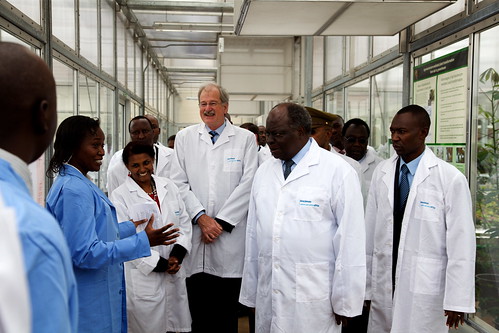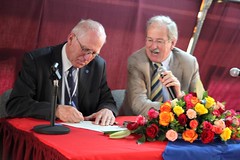An extensive agricultural landscape typical of central rural Malawi (photo credit: ILRI/Mann).
Agricultural systems analyst Mario Herrero, who leads a Sustainable Livestock Futures group at the International Livestock Research Institute (ILRI) in Kenya, gave a slide presentation last November at an invitation-only US National Academy of Sciences’ scoping meeting on The role of animal agriculture in a sustainable 21st century global food system, held in Washington DC’s Dupont Circle.
Among the conclusions Herrero makes in his slide presentation, Food security, livelihoods and livestock in the developing world, is the need to change our agricultural investment paradigms so that we invest not only in the high-potential agricultural lands of the past (many of which, he says, are already ‘maxed out’), but also in the agricultural lands of the future.
What are these ‘agricultural lands of the future’? Well, those on which relatively extensive mixed crop-and-livestock systems are being practiced, for one.
For more on this topic, see ILRI’s current corporate report: Back to the future: Revisiting mixed crop-livestock systems, 2010, the foreword of which, by ILRI director general Carlos Seré and ILRI board chair Knut Hove, follows.
ILRI’s Carlos Seré and Knut Hove say it’s ‘mixed farms’,
more than breadbaskets or ricebowls,
that will feed the world over the next two decades.
A hitherto disregarded vast group of farmers—those mixing crops with livestock on ‘in between’ lands—neither high-potential farmlands nor low-potential rangelands—are heavyweights in global food security.
This year’s corporate report by the International Livestock Research Institute (ILRI) looks ‘back to the future’—to the thousand million farmers practicing small-scale mixed crop-and-livestock agriculture in poor countries—the kind of seemingly old-fashioned family farming systems that have become so fashionable in recent years among those wanting to reform the industrial food systems of rich countries.
Scientists at ILRI and seven other leading international agricultural research organizations around the world recently looked at the future of this form of farming and determined that it is ‘mixed farms’—not breadbaskets or ricebowls—that will feed most people over the next two decades.
Their report shows that it is not big efficient farms on high potential lands but rather one billion small ‘mixed’ family farmers tending rice paddies or cultivating maize and beans while raising a few chickens and pigs, a herd of goats or a cow or two on relatively extensive rainfed lands who feed most of the world’s poor people today. This same group, the report indicates, is likely to play the biggest role in global food security over the next several decades, as world population grows and peaks (at 9 billion or so) with the addition of another 3 billion people.
Remarkably, this is the first study ever to investigate the state of the world’s most prevalent kind of farmers—those who keep animals as well as grow crops. A major implication of the new report is that governments and researchers are mistaken to continue looking to high-potential lands and single-commodity farming systems as the answer to world hunger. As the study shows, many highly intensive agricultural systems are reaching their peak capacity to produce food and should now focus on sustaining rather than increasing yields.
A hitherto disregarded vast group of farmers—those mixing crops with livestock on ‘in between’ lands—neither high-potential farmlands nor low-potential rangelands—are heavyweights in global food security.
The authors of this multi-institutional and multi-disciplinary study, most belonging to centres of the Consultative Group on International Agricultural Research (CGIAR), agree with many other experts that we need to bring our focus back to small-scale farms. But this report goes further, distinguishing one particular kind of small-scale farmer that should be our focus: this is the mixed farmer growing crops and raising animals in the world’s more extensive agricultural systems, which are described in detail on the next page.
These ‘mixed extensive’ farms make up the biggest, poorest and most environmentally sustainable agricultural system in the world. It is time we invested heavily in this particular kind of farming system. Here is where there remain the biggest yield gaps. Here is where we can make the biggest difference.
The billions of dollars promised by the international donor community to fund small-scale farming in developing countries are likely to fail unless policies are reoriented towards this particular, most ubiquitous, and till now most neglected, form of agriculture. What this ‘extensive frontier’ needs are the most basic forms of infrastructure and services. With these at hand, the world’s extensive mixed farmers will be in good position to scale up their food production to meet future needs.
Read ILRI’s corporate report: Back to the future: Revisiting mixed crop-livestock systems, 2010.
Watch a 4-minute ILRI photofilm (audio with still pictures) illustrating the importance of small-scale mixed crop-and-livestock farmers: Tribute to the Unsung Heroes of Small-scale Food Production, 2011.
Those wanting more detail on the future of mixed farming should consult the research report by the CGIAR Systemwide Livestock Programme: Drivers of change in crop-livestock systems and their potential impacts on agroecosystems services and human well-being to 2030, 2009.









 This post is part of a series associated with the ILRI Annual Program Meeting in Addis Ababa, April 2010.
This post is part of a series associated with the ILRI Annual Program Meeting in Addis Ababa, April 2010.